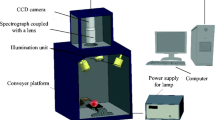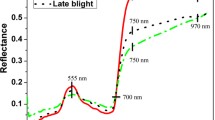Abstract
Early automatic detection of fungal infections in post-harvest citrus fruits is especially important for the citrus industry because only a few infected fruits can spread the infection to a whole batch during operations such as storage or exportation, thus causing great economic losses. Nowadays, this detection is carried out manually by trained workers illuminating the fruit with dangerous ultraviolet lighting. The use of hyperspectral imaging systems makes it possible to advance in the development of systems capable of carrying out this detection process automatically. However, these systems present the disadvantage of generating a huge amount of data, which must be selected in order to achieve a result that is useful to the sector. This work proposes a methodology to select features in multi-class classification problems using the receiver operating characteristic curve, in order to detect rottenness in citrus fruits by means of hyperspectral images. The classifier used is a multilayer perceptron, trained with a new learning algorithm called extreme learning machine. The results are obtained using images of mandarins with the pixels labelled in five different classes: two kinds of sound skin, two kinds of decay and scars. This method yields a reduced set of features and a classification success rate of around 89%.




Similar content being viewed by others
References
Aleixos, N., Blasco, J., Navarrón, F., & Moltó, E. (2002). Multispectral inspection of citrus in real time using machine vision and digital signal processors. Computers and Electronics in Agriculture, 33(2), 121–137.
Ariana, D. P., Guyer, D. E., & Shrestha, B. (2006). Integrating multispectral reflectance and fluorescence imaging for defect detection on apples. Computers and Electronics in Agriculture, 50, 148–161.
Balasundaram, D., Burks, T. F., Bulanona, D. M., Schubert, T., & Lee, W. S. (2009). Spectral reflectance characteristics of citrus canker and other peel conditions of grapefruit. Postharvest Biology and Technology, 51, 220–226.
Bennedsen, B. S., Peterson, D. L., & Tabb, A. (2007). Identifying apple surface defects using principal components analysis and artificial neural networks. Transactions of the ASABE, 50(6), 2257–2265.
Blanc, P. G. R., Blasco, J., Moltó, E., Gómez-Sanchis, J., Cubero. S. (2009). System for the automatic selective separation of rotten citrus fruit. European patent EP2133157A1.
Blanc, P. G. R., Blasco, J., Moltó, E., Gómez-Sanchis, J., Cubero, S. (2010). System for the automatic selective separation of rotten citrus fruit. United States patent US2010/0121484A1.
Blasco, J., Aleixos, N., Gómez, J., & Moltó, E. (2007). Citrus sorting by identification of the most common defects using multispectral computer vision. Journal of Food Engineering, 83(3), 384–393.
Blasco, J., Aleixos, N., Gómez-Sanchis, J., & Moltó, E. (2009). Recognition and classification of external skin damage in citrus fruits using multispectral data and morphological features. Biosystems Engineering, 103, 137–145.
Bradley, A. P. (1997). The use of the area under the ROC curve in the evaluation of machine learning algorithms. Pattern Recognition, 30(7), 1145–1159.
Cubero, S., Aleixos, N., Moltó, E., Gómez-Sanchis, J., & Blasco, J. (2011). Advances in machine vision applications for automatic inspection and quality evaluation of fruits and vegetables. Food and Bioprocess Technology, 4(4), 487–504.
Du, C.-J., & Sun, D.-W. (2009). Retrospective shading correlation of confocal laser scanning microscopy beef images for three-dimensional visualization. Food and Bioprocess Technology, 2, 167–176.
Eckert, J., & Eaks, I. (1989). Postharvest disorders and diseases of citrus. The citrus industry. Berkeley: University California Press.
Farrera-Rebollo, R. R., Salgado-Cruz, M. P., Chanona-Pérez, J., Gutiérrez-López, G. F., Alamilla-Beltrán, L., & Calderón-Domínguez, G. (2011). Evaluation of image analysis tools for characterization of sweet bread crumb structure. Food and Bioprocess Technology. doi:10.1007/s11947-011-0513-y.
Fawcett, T. (2006). An introduction to ROC analysis. Pattern Recognition Letters, 27(8), 861–874.
Gaffney, J. J. (1973). Reflectance properties of citrus fruits. Transactions of the ASAE, 16(2), 310–314.
Gitelson, A., Merzyak, M. N., & Lichtenthaler, H. K. (1996). Detection of red-edge position and chlorophyll content by reflectance measurements near 700 nm. Journal of Plant Physiology, 148, 501–508.
Gómez-Sanchis, J., Gómez-Chova, L., Aleixos, N., Camps-Valls, G., Montesinos-Herrero, C., Moltó, E., & Blasco, J. (2008). Hyperspectral system for early detection of rottenness caused by Penicillium digitatum in mandarins. Journal of Food Engineering, 89(1), 80–86.
Gómez-Sanchis, J., Moltó, E., Camps-Valls, G., Gómez-Chova, L., Aleixos, N., & Blasco, J. (2008). Automatic correction of the effects of the light source on spherical objects. An application to the analysis of hyperspectral images of citrus fruits. Journal of Food Engineering, 85(2), 191–200.
Gómez-Sanchis, J., Martín-Guerrero, J. D., Soria-Olivas, E., Martínez-Sober, M., Magdalena-Benedito, R., & Blasco, J. (2012). Detecting rottenness caused by Penicillium in citrus fruits using machine learning techniques. Expert Systems with Applications, 39(1), 780–785.
Guyon, I., & Elisseeff, A. (2003). An introduction to variable and feature selection. Journal of Machine Learning Research, 3, 1157–1182.
Haboudane, D., Miller, J. R., Tremblay, N., Zarco-Tejada, P. J., & Dextraze, L. (2002). Integrated narrow-band vegetation indices for prediction of crop chlorophyll content for application to precision agriculture. Remote Sensing of Environment, 81, 416–426.
Huang, G. B., Zhu, Q. Y., & Siew, C. K. (2006). Extreme learning machine: Theory and applications. Neurocomputing, 70, 489–501.
Huang, Y., Kangas, L. J., & Rasco, B. A. (2007). Applications of artificial neural networks (ANNs) in food science. Critical Reviews in Food Science and Nutrition, 47(2), 113–126.
Jiménez-Cuesta, M., Cuquerella, J., & Martínez-Jávega, J. M. (1981). Determination of a color index for citrus fruit degreening. In: Proceedings of the International Society of Citriculture, 2, 750–753.
Karimi, Y., Maftoonazad, N., Ramaswamy, H. S., Prasher, S. O., & Marcotte, M. (2009). Application of hyperspectral technique for color classification avocados subjected to different treatments. Food and Bioprocess Technology. doi:10.1007/s11947-009-0292-x.
Kim, D. G., Burks, T. F., Qin, J., & Bulanon, D. M. (2009). Classification of grapefruit peel diseases using color texture feature analysis. International Journal of Agricultural and Biological Engineering, 2(3), 41–50.
Kondo, N., Ahmad, U., Monta, M., & Murase, H. (2000). Machine vision based quality evaluation of Iyokan orange fruit using neural networks. Computers and Electronics in Agriculture, 29, 135–147.
Kurita, M., Kondo, N., Shimizu, H., Ling, P., Falzea, P. D., Shiigi, T., Ninomiya, K., Nishizu, T., & Yamamoto, K. (2009). A double image acquisition system with visible and UV LEDs for citrus fruit. Journal of Robotics and Mechatronics, 21(4), 533–540.
Li, J., Rao, X., & Ying, Y. (2011). Detection of common defects on oranges using hyperspectral reflectance imaging. Computers and Electronics in Agriculture, 78(1), 38–48.
López-García, F., Andreu-García, A., Blasco, J., Aleixos, N., & Valiente, J. M. (2010). Automatic detection of skin defects in citrus fruits using a multivariate image analysis approach. Computers and Electronics in Agriculture, 71, 189–197.
Lorente, D., Aleixos, N., Gómez-Sanchis, J., Cubero, S., García-Navarrete, O. L., & Blasco, J. (2011). Recent advances and applications of hyperspectral imaging for fruit and vegetable quality assessment. Food and Bioprocess Technology. doi:10.1007/s11947-011-0725-1.
Magwaza, L. S., Opara, U. L., Nieuwoudt, H., Cronje, P. J. R., Saeys, W., & Nicolaï, B. (2011). NIR spectroscopy applications for internal and external quality analysis of citrus fruit—a review. Food and Bioprocess Technology.. doi:10.1007/s11947-011-0697-1.
Manickavasagan, A., Jayas, D. S., White, N. D. G., & Paliwal, J. (2010). Wheat class identification using thermal imaging. Food and Bioprocess Technology, 3(3), 450–460.
Naidu, R. A., Perry, E. M., Pierce, F. J., & Mekuria, T. (2009). The potential of spectral reflectance technique for the detection of Grapevine leafroll-associated virus-3 in two redberried wine grape cultivars. Computers and Electronics in Agriculture, 66, 38–45.
Obagwu, J., & Korsten, L. (2003). Integrated control of citrus green and blue molds using Bacillus subtilis in combination with sodium bicarbonate or hot water. Postharvest Biology and Technology, 28(1), 187–194.
Obenland, D., Margosan, D., Collins, S., Sievert, J., Fjeld, K., Arpaia, M. L., Thompson, J., & Slaughter, D. (2009). Peel fluorescence as a means to identify freeze-damaged navel oranges. HortTechnology, 19(2), 379–384.
Palou, L., Smilanik, J., Usall, J., & Viñas, I. (2001). Control postharvest blue and green molds of oranges by hot water, sodium carbonate, and sodium bicarbonate. Plant Disease, 85, 371–376.
Plaza, A., Benediktsson, J. A., Boardman, J. W., Brazile, J., Bruzzone, L., Camps-Valls, G., Chanussot, J., Fauvel, M., Gamba, P., Gualtieri, A., Marconcini, M., Tilton, J. C., & Trianni, G. (2009). Recent advances in techniques for hyperspectral image processing. Remote Sensing of Environment, 113(1), S110–S122.
Prechelt, L. (1996). A quantitative study of experimental evaluations of neural network learning algorithms: Current research practice. Neural Networks, 9(3), 457–462.
Qin, J., Burks, T. F., Ritenour, M. A., & Bonn, W. G. (2009). Detection of citrus canker using hyperspectral reflectance imaging with spectral information divergence. Journal of Food Engineering, 93, 183–191.
Quevedo, R., & Aguilera. (2010). Color computer vision and stereoscopy for estimating firmness in the salmon (Salmon salar) fillets. Food and Bioprocess Technology, 3(4), 561–567.
Quevedo, R., Aguilera, J. M., & Pedreschi, F. (2010). Color of salmon fillets by computer vision and sensory panel. Food and Bioprocess Technology, 3(5), 637–643.
Rao, C. R., & Mitra, S. K. (1972). Generalized inverse of matrices and its applications. New York: Wiley.
Rifkin, R., & Klautau, A. (2004). In defense of one-vs-all classification. Journal of Machine Learning Research, 5, 101–141.
Rondeaux, G., Steven, M., & Baret, F. (1996). Optimization of soil-adjusted vegetation indices. Remote Sensing of Environment, 55, 95–107.
Serrano AJ, Soria E, Martín JD, Magdalena R & Gómez J (2010) Feature selection using ROC curves on classification problems. In: International Joint Conference on Neural Networks, IJCNN 2010, 28th–30th July 2010. Barcelona, Spain. Proceedings, pp 1980–1985.
Shih, F. Y. (2010). Image processing and pattern recognition: Fundamentals and techniques. New York: Wiley-IEEE.
Slaughter, D. C., Obenland, D. M., Thompson, J. F., Arpaia, M. L., & Margosan, D. A. (2008). Non-destructive freeze damage detection in oranges using machine vision and ultraviolet fluorescence. Postharvest Biology and Technology, 48, 341–346.
Sun, D.-W. (Ed.). (2010). Hyperspectral imaging for food quality analysis and control. London: Academic.
Tucker, C. J. (1979). Red and photographic infrared linear combinations for monitoring vegetation. Remote Sensing of Environment, 8(2), 127–150.
Unay, D., & Gosselin, B. (2006). Automatic defect segmentation of ‘Jonagold’ apples on multi-spectral images: A comparative study. Postharvest Biology and Technology, 42, 271–279.
Xu, H. R., Ying, Y. B., Fu, X. P., & Zhu, S. P. (2007). Near-infrared spectroscopy in detecting leaf miner damage on tomato leaf. Biosystems Engineering, 96(4), 447–454.
Yang, C. M., Cheng, C. H., & Chen, R. K. (2007). Changes in spectral characteristics of rice canopy infested with brown planthopper and leaffolder. Crop Science, 47, 329–335.
Acknowledgements
This work was partially funded by the Instituto Nacional de Investigación y Tecnologia Agraria y Alimentaria de España (INIA) through research project RTA2009-00118-C02-01 and by the Ministerio de Ciencia e Innovación de España (MICINN) through research project DPI2010-19457, both projects with the support of European FEDER funds. This work was also been partially funded by Universitat de València through project UV-INVAE11-41271.
Author information
Authors and Affiliations
Corresponding author
Rights and permissions
About this article
Cite this article
Lorente, D., Aleixos, N., Gómez-Sanchis, J. et al. Selection of Optimal Wavelength Features for Decay Detection in Citrus Fruit Using the ROC Curve and Neural Networks. Food Bioprocess Technol 6, 530–541 (2013). https://doi.org/10.1007/s11947-011-0737-x
Received:
Accepted:
Published:
Issue Date:
DOI: https://doi.org/10.1007/s11947-011-0737-x




